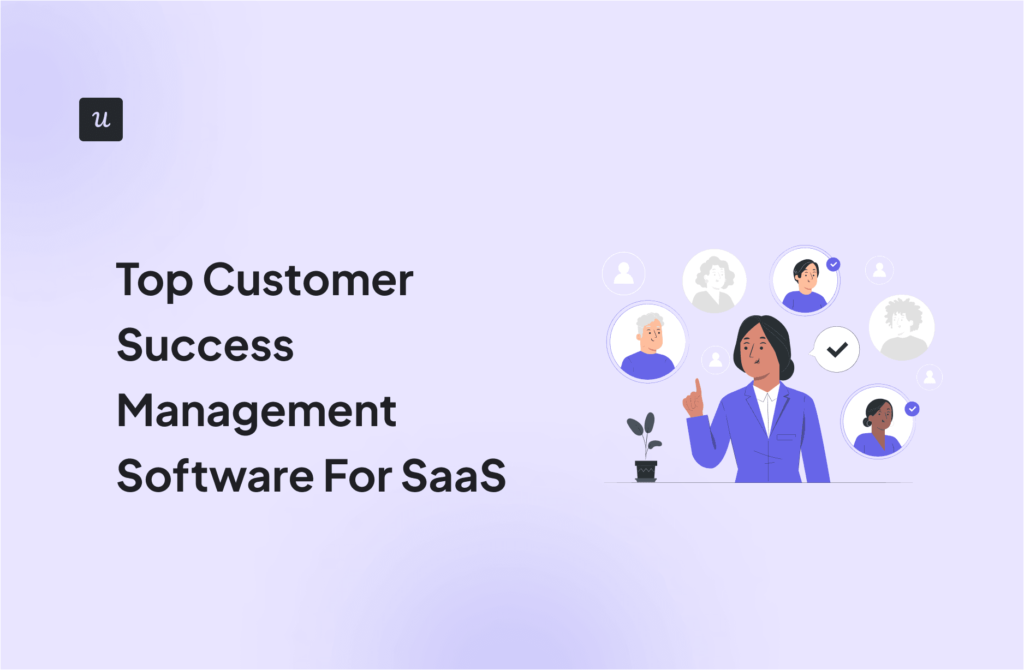
Customer Engagement Model: 8 Types for Increasing Engagement and Satisfaction
What’s the best customer engagement model for your SaaS? If you’re looking for the answer, this article can help.
You will learn:
- The benefits of using a customer engagement model.
- Different stages of customer engagement.
- 8 popular customer engagement models.
- Factors to consider when choosing one.
Try Userpilot Now
See Why 1,000+ Teams Choose Userpilot

What is a customer engagement model?
A customer engagement model is a framework that guides how a company interacts with its customers throughout the customer lifecycle: from the moment they first learn about its product until they become loyal customers (or stop using it).
The purpose?
To create a positive customer experience and keep your customers interested in the product.
How does an effective customer engagement model benefit your company?
A successful customer engagement model helps SaaS companies generate more revenue and increase business profitability.
Let me explain:
By regularly engaging with customers throughout their journey and helping them maximize the product value, you can build stronger relationships, which translates into long-term customer loyalty and retention and consequently, higher customer lifetime value.
It gets better.
Engaged customers often become brand advocates. They promote your SaaS products through word-of-mouth, which facilitates new customer acquisition while reducing its cost.
Additionally, a well-implemented customer engagement strategy helps you gather valuable customer feedback, allowing you to continuously improve your product and better satisfy customer needs.
Different stages of customer engagement
The choice of engagement strategies depends on the stage in the customer journey.
We distinguish 5 main ones.
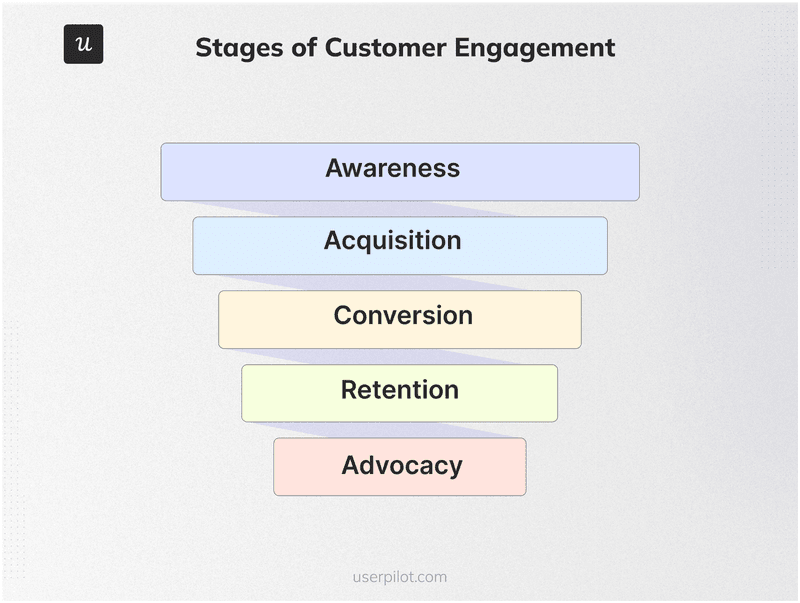
Stage 1: Awareness
At the awareness stage, customers learn about the product. For example, from your paid ads, social media posts, webinars, or word of mouth.
Stage 2: Acquisition
In SaaS, acquisition usually happens when the customer signs up for the free trial or freemium plan.
Apart from your landing page and sign-up form, common touchpoints at this stage include customer reviews, comparison blog posts, or product demos.
They help the customer understand what the product has to offer and how it stands out from the competition.
Stage 3: Conversion
Conversion happens when the customer upgrades to a paid plan.
In product-led growth, this normally happens after trying out the product and experiencing its benefits.
To help them get to this stage, SaaS teams may offer in-app guidance, self-service resources, and support from a customer success manager.
Stage 4: Retention
The retention stage is all about building customer loyalty so that they don’t start looking toward competing products.
You can achieve this through secondary onboarding and ongoing customer education, which help customers master more advanced functionality. Thanks to this, they can realize the full product potential and become its power users.
Stage 5: Advocacy
At the advocacy stage, your customers promote your product to their friends and colleagues.
Many satisfied customers do it organically, via word-of-mouth, but you can speed up the process by creating referral programs and prompting customers to leave reviews on sites like G2 or Capterra.
8 Customer engagement models to implement
What customer engagement models should you consider for your SaaS?
Here are 8 of the most common ones.
1. USP model
The USP or Unique Selling Point model focuses on communicating what sets your product apart from competitors, like unique features or benefits that other companies don’t offer.
If you offer such unique capabilities that competitors don’t, this could be an engagement model for you, especially at the early stages of the customer journey.
But bear in mind its limitations: limited scope and focus. Highlighting your USPs may not be enough to engage and retain customers long-term unless yours is a highly innovative product and you’re constantly adding new features.
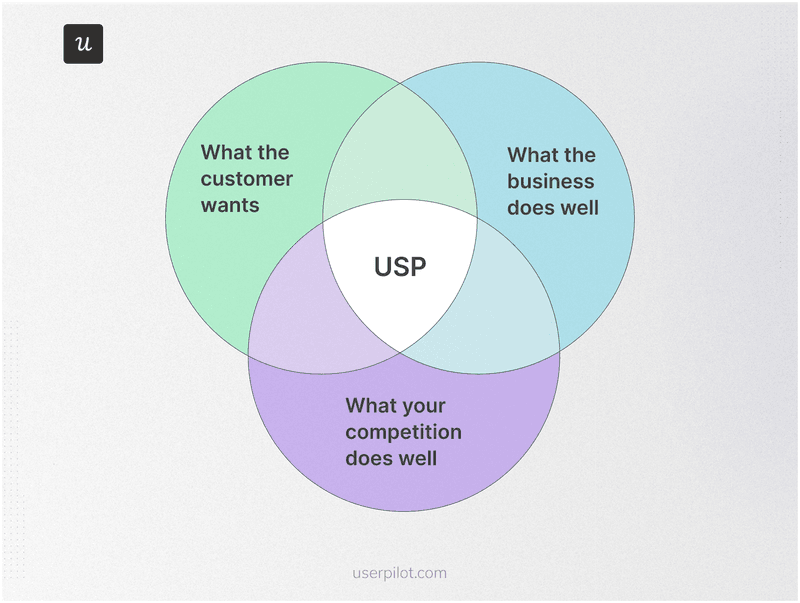
2. High-touch engagement model
The high-touch engagement model is based on highly personalized customer interactions.
To attract, convert, and retain customers, you provide customers with top-notch service and support, such as through dedicated sales and customer success representatives. They may take demo calls, onboard users, and assist them whenever needed.
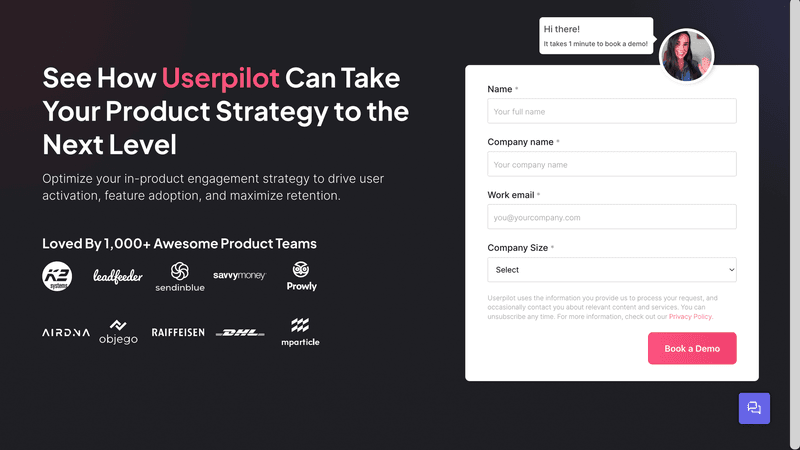
Customization and attention to individual customer needs allow you to better understand and satisfy customer needs and boost your brand reputation.
You can onboard and engage mobile app users by creating personalized messaging, push notifications, and surveys.
The downside is that this engagement model is very resource-intensive and difficult to scale. Even if you had the money to hire all the sales reps and support agents you need, there are only so many such people available.
So, the model is best suited for complex and niche products or enterprise solutions for high-value customers.
3. Low-touch engagement model
A low-touch customer engagement model is the opposite of the previous one. Instead of personalized support and attention, it relies on automation and self-service solutions like chatbots or in-app flows to engage customers at scale.
This works well for companies with simpler, lower-cost products that don’t require extensive support. If your product has an intuitive, user-friendly UI and straightforward features, low-touch engagement might be the way to go.
The main drawback of this approach is that it limits your opportunities to get to know your customers and forge strong relationships.
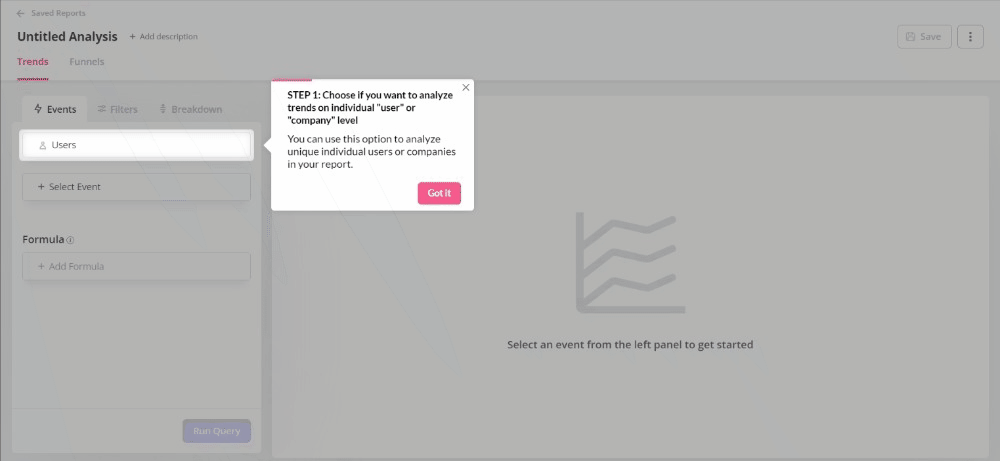
4. Customer segmentation model
In the customer segmentation model, you divide the customer base into groups based on various criteria, like demographics, behavior patterns, and customer journey stage, and customize engagement for each group.
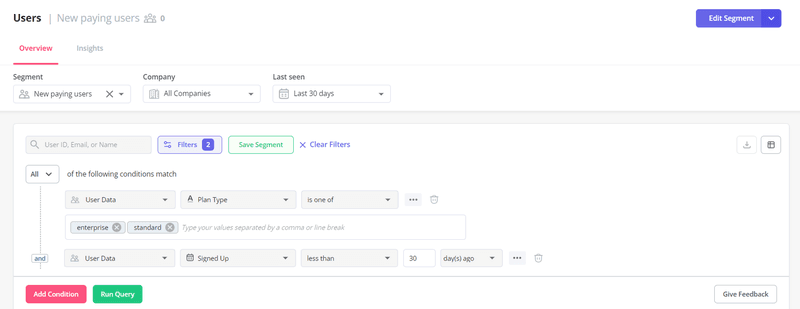
This model is particularly effective for companies with a diverse customer base and/or multiple use cases.
By tailoring engagement strategies to each segment, you can provide more personalized and relevant experiences for higher customer satisfaction and retention.
Canva is a good example: it uses a quick welcome survey to group users based on their jobs to be done and uses the information to customize their dashboards with relevant templates.
5. Customer success manager model
The model relies on customer success managers who work closely with customers to enable them to achieve their goals.
By being in regular contact with customers, CSMs can better understand their needs and develop bespoke strategies to satisfy them. Their insights can also inform future product development.
Having a dedicated point of contact improves customer-business communication and strengthens the mutually beneficial relationship, leading to increased brand loyalty and retention.
The CSM-driven model shares some of the downsides of the high-touch model: hiring and training enough staff can be a challenge and is costly as well. This isn’t viable if you have a low-value product and need to engage and support a large customer base.
6. Automated retention model
The automated retention model leverages tools like event-based triggering to engage customers with messages for contextual support and targeted communication.
Picture this: you’ve identified a series of customer actions that lead to customer churn.
You bundle them together into a custom event and use it to trigger an in-app survey to investigate the reasons why they might be churning, or a flow to help them overcome friction and adopt key features.
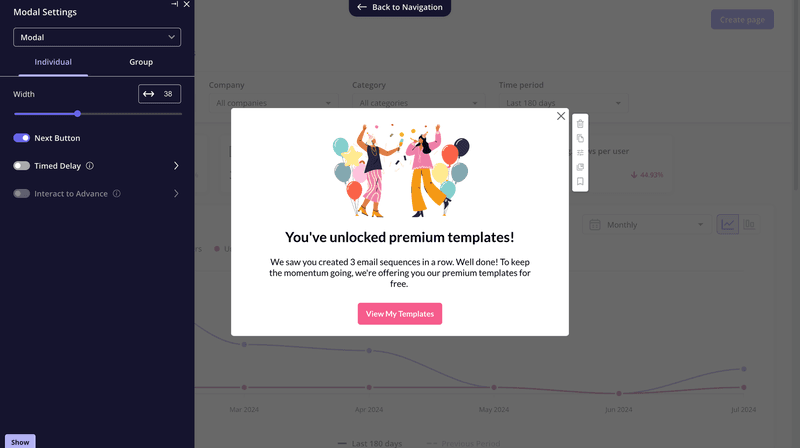
Automated engagement is a cost-effective and fool-proof approach. Once you set it up, it doesn’t require any manual support, which increases customer experience consistency and reduces the risk of errors.
Having said that, you may first need to spend some money on the right software, and customers may perceive it as impersonal.
7. Collaborative product roadmap model
The collaborative product roadmap strategy allows customers to contribute their ideas and feedback to guide product development.
You can do it by enabling a customer-facing roadmap where customers can vote up and down features or by collecting feature requests in-app.
This model has multiple benefits:
- It increases the transparency by showing customers where the product is heading.
- The opportunity to shape the roadmap increases their involvement and strengthens their connection with the brand.
- Gathering customer ideas allows you to build a product that’s better aligned with their needs and expectations.
The main limitation of the approach is that customers don’t often understand why exactly they need certain features or how to best solve their problems. If you rely on their contributions, you risk falling behind the more innovative competitors.
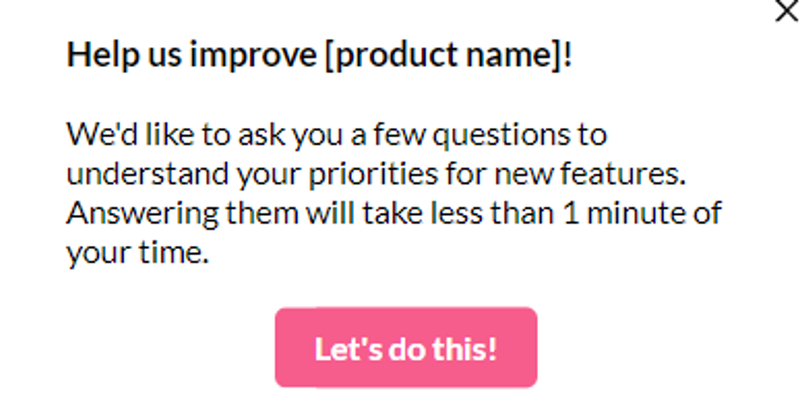
8. Hybrid model
The hybrid model combines elements of high-touch and low-touch engagement strategies for a balanced approach.
This model suits SaaS companies with a diverse product range or customer base.
By using a mix of personalized interactions for high-value customers and automated support for others, you can efficiently manage resources while still delivering high-quality service.
For example, you could use high-touch engagement tactics for enterprise customers while employing low-touch methods for customers on free or lower-paid plans.
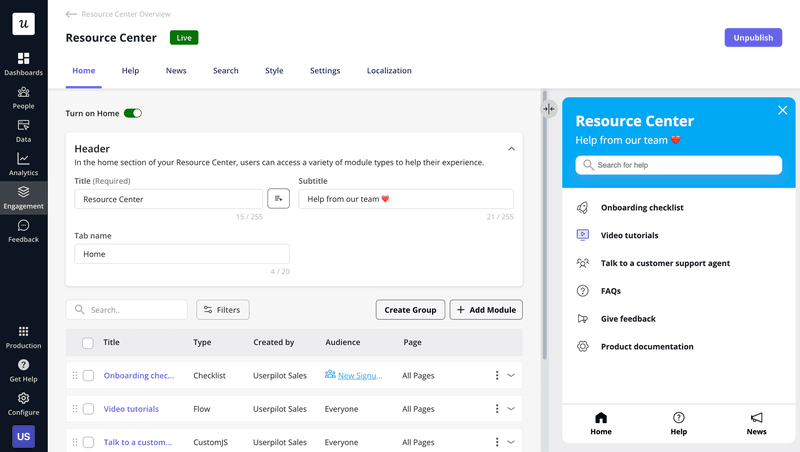
How to choose the right customer engagement model?
Let’s wrap up by looking at the factors to consider when choosing the best engagement model for your SaaS:
- Product complexity: If your product is complex and requires extensive setup or customization, a high-touch engagement model is suitable. For simpler, more intuitive products, a low-touch or automated engagement model may be more appropriate.
- Customer segmentation: Larger customers with significant accounts may benefit from a high-touch model, while smaller businesses or individual users may be better served by low-touch or automated models, which provide efficient and scalable support. If you have a mix of them, go for the hybrid model.
- Cost of the product: Expensive products often justify a high-touch engagement model because the revenue generated can support the cost of personalized service. For lower-priced products, an automated or low-touch model can help maintain profitability by reducing support costs.
- Business goals: If your goal is to scale rapidly or minimize costs, low-touch or automated models can support a growing customer base without a corresponding increase in support staff. If increasing customer satisfaction and loyalty is a priority, high-touch models can work better.
- Resource availability: If you have a large, skilled support team, you might be able to offer high-touch engagement effectively. Without robust automation software, building a low-touch or automated engagement model could be challenging.
- Competitive landscape: In highly competitive markets, a high-touch model can differentiate your brand by offering superior customer service. In less competitive markets, efficiency might be more critical, making low-touch or automated models more suitable.
- Customer expectations: In certain markets or industries (like SaaS in Germany), customers may expect personalized service and support, and a high-touch model is necessary to meet these expectations.
Customer engagement model summarized
Ongoing customer engagement enables companies to attract new customers, retain them long-term, and build a positive brand image.
The choice of the customer engagement model and specific customer engagement strategies depends on factors such as product complexity, available resources, and customer expectations. Often, a combination of various approaches might be the best fit.
Regardless of which model you choose, Userpilot can help you create and execute your customer engagement plan. Book a demo to find out more!







